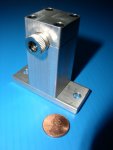There are several people here who have killed a lot more diodes than I'd care to, and I was wondering if I could get your input on this subject.
How important is it to heat sink these (mostly I'm thinking of the phr-803t's) diodes effectively?
It would seem that conventional wisdom is to use the largest heat-sink possible, but then I see builds like the leadlights, and the keychain builds, but don't hear anything about decreased diode lifespan.
Perhaps these diodes have become inexpensive enough to justify builds that don't have long life expectancy, or perhaps it's becoming clear that the diodes suffer more from being over driven than from heat saturation?
Any insight would be interesting to me.
How important is it to heat sink these (mostly I'm thinking of the phr-803t's) diodes effectively?
It would seem that conventional wisdom is to use the largest heat-sink possible, but then I see builds like the leadlights, and the keychain builds, but don't hear anything about decreased diode lifespan.
Perhaps these diodes have become inexpensive enough to justify builds that don't have long life expectancy, or perhaps it's becoming clear that the diodes suffer more from being over driven than from heat saturation?
Any insight would be interesting to me.






